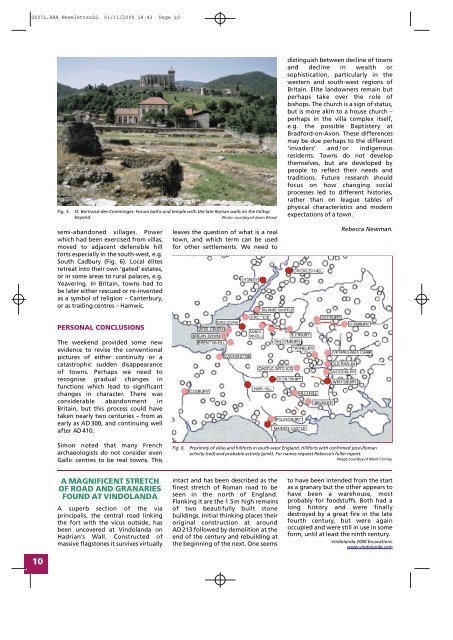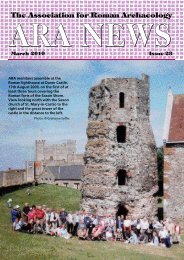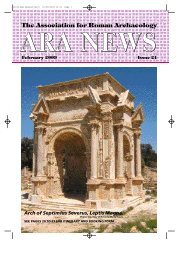G0071,ARA <strong>Newsletter</strong><strong>22</strong> 01/11/2009 18:43 Page 10Fig. 5.St. Bertrand-des-Comminges. Forum baths and temple with the late <strong>Roman</strong> walls on the hilltopbeyond.Photo: courtesy of Jason Wood.distinguish between decline of townsand decline in wealth orsophistication, particularly in thewestern and south-west regions ofBritain. Elite landowners remain butp e rhaps take over the role ofbishops. The church is a sign of status,but is more akin to a house church –perhaps in the villa complex itself,e.g. the possible Baptistery atBrad<strong>for</strong>d-on-Avon. These differencesmay be due perhaps to the different‘invaders’ and / or indigenousresidents. Towns do not developthemselves, but are developed bypeople to reflect their needs andtraditions. Future research shouldfocus on how changing socialprocesses led to different histories,rather than on league tables ofphysical characteristics and modernexpectations of a town.semi-abandoned villages. Powerwhich had been exercised from villas,moved to adjacent defensible hill<strong>for</strong>ts especially in the south-west, e.g.South Cadbury (Fig. 6). Local élitesretreat into their own ‘gated’ estates,or in some areas to rural palaces, e.g.Yeavering. In Britain, towns had tobe later either rescued or re-inventedas a symbol of religion – Canterbury,or as trading centres – Hamwic.leaves the question of what is a realtown, and which term can be used<strong>for</strong> other settlements. We need toRebecca Newman.PERSONAL CONCLUSIONSThe weekend provided some newevidence to revise the conventionalpictures of either continuity or acatastrophic sudden disappearanceof towns. Perhaps we need torecognise gradual changes infunctions which lead to significantchanges in character. There wasconsiderable abandonment inBritain, but this process could havetaken nearly two centuries – from asearly as AD 300, and continuing wellafter AD 410.Simon noted that many Fre n c harchaeologists do not consider evenGallic centres to be real towns. ThisFig. 6.Proximity of villas and hill<strong>for</strong>ts in south-west England. Hill<strong>for</strong>ts with confirmed post-<strong>Roman</strong>activity (red) and probable activity (pink). For names request Rebecca’s fuller report.Image courtesy of Mark Corney.A MAGNIFICENT STRETCHOF ROAD AND GRANARIESFOUND AT VINDOLANDAA superb section of the viaprincipalis, the central road linkingthe <strong>for</strong>t with the vicus outside, hasbeen uncovered at Vindolanda onH a d r i a n ’s Wall. Constructed ofmassive flagstones it survives virtuallyintact and has been described as thefinest stretch of <strong>Roman</strong> road to beseen in the north of England.Flanking it are the 1.5m high remainsof two beautifully built stonebuildings. Initial thinking places theiroriginal construction at aro u n dAD213 followed by demolition at theend of the century and rebuilding atthe beginning of the next. One seemsto have been intended from the startas a granary but the other appears tohave been a warehouse, mostprobably <strong>for</strong> foodstuffs. Both had along history and were finallydestroyed by a great fire in the latef o u rth century, but were againoccupied and were still in use in some<strong>for</strong>m, until at least the ninth century.Vindolanda 2008 Excavations.www.vindolanda.com10
G0071,ARA <strong>Newsletter</strong><strong>22</strong> 01/11/2009 18:43 Page 11BOOK REVIEWSBristol in 1807Impressions of the city at thetime of AbolitionAnthony BeesonRedcliffe PressISBN 978-1-906593-26-1240 pp., 37 illustrations in colourand 158 in black & white.Paperback £10.00.Review by Gavin SiddollThe publication of a new book byone of the ARA’s Board of Trustees isnot a notable event in itself, and itmight be considered that a book onearly nineteenth century Bristol haslittle claim to be featured in thesepages. However, Anthony Beeson’slook into the follies, culture andhorrors of late Georgian Bristol is afascinating volume that this reviewerbelieves will be of interest to mostARA members.The book arises from the researchdone by Anthony Beeson <strong>for</strong> theextremely successful Heritage Lotteryfunded exhibition held at TheCentral Reference Library in Bristolf rom 2007 to 2008. Althougharranged as part of the nation-wideevents commemorating theAbolition of Slavery, from the startthis exhibition was planned as beingabout everyday life in the city as livedby all classes and creeds in that yearand not yet another breast-beatinge x e rcise about slavery. Furt h e rfunding from the HLF enabled thewishes of visitors to the exhibition tocome to pass, and a permanentrecord of all the research done <strong>for</strong>the exhibition to be published. Theresulting lavishly produced, butmodestly priced, volume is the lastinglegacy to the exhibition and to thewriter. As might be expected from anauthor who is a committed <strong>Roman</strong>istthe book includes a chapter entitledSea Mills: In Search of Ancient Rome,that includes a rare account by G. W.Manby of the <strong>Roman</strong> settlement as itappeared to the antiquarian visitorat the time, and of other such sites inthe area where visitors from Bristolcould be close to their ancestors. Ofparticular interest in the Sea Millschapter is a mid-eighteenth centurymap of the area that shows the fieldboundaries on the site of thesettlement appearing to mimic theknown streets of the <strong>Roman</strong> port.This, like many of the colour andblack and white illustrations in thebook, have never be<strong>for</strong>e beenpublished.The chapter on costume I found ap a rticular delight. The author’srecent discovery that the classicaldress so typical of the women ofthe period derives from EmmaHamilton’s attempts to introduce herG recian styles was of part i c u l a rinterest. Her invention of an undergarmentthat resulted in the wearerappearing pregnant whilst aping theshape of the ’Grecian Venus‘ securedthe style and the followers that it hadpreviously lacked. By 1807 the stateof women’s dress was scandalising<strong>Roman</strong> Mosaics ofBritainVolume III South-East BritainD. S. Neal and S. R. CoshSociety of Antiquaries of LondonISBN 978-0-85431-289-4606 pp., 530 illustrations, many incolour.Hardback.Review ContributedThe launch of the third volume of the<strong>Roman</strong>o-British mosaic corpus tookplace at the apartments of theSociety of Antiquaries in BurlingtonHouse, Piccadilly, London on 25thJune. It was a fairly low-key affair,being <strong>for</strong> a middle volume of theseries. It was accompanied by brieflectures by the authors, David Nealand Steve Cosh. Volume III of thisfour volume set, describing andthe press and gre a t l yemploying the satiricalc a rtoonists. “From Bombazeento Bum-be-Seen”joked one cartoon feature din the illustrations.These are just twochapters out of manyequally fascinating, in abook that it is a truedelight to dip into. Fromtales of rude and idleboys to a schoolmasterwho invented a boyspanking machine and a kitep ropelled carriage, in which hetransported his family and horse (ona trailer) to Marlborough <strong>for</strong> the day,or of Slut, the pig, who loved to actlike a pointer dog. The author hasincluded reprints of long <strong>for</strong>gottenpoems of the period, newspaperreports and accounts by residentsand visitors to the city “by mudcemented and by smoke obscur’d”.Bristol in 1807 is more than a bookabout one provincial city. It is amicrocosm of England itself at thatperiod. A land where one could getrich on the national lottery or ruinedby the war with France. I thoroughlyenjoyed it. It proves that whateverthe age we live in, we are basicallystill the same Britons.An illustration from Part One. Bancroft <strong>Roman</strong>villa, Buckinghamshire, from a painting byD. S. Neal.illustrating all the <strong>Roman</strong>o-Britishmosaics, covers Berkshire, Buckinghamshire,Essex, Hampshire and the11
- Page 2 and 3: G0071,ARA Newsletter22 01/11/2009 1
- Page 4 and 5: G0071,ARA Newsletter22 01/11/2009 1
- Page 6 and 7: G0071,ARA Newsletter22 01/11/2009 1
- Page 8 and 9: G0071,ARA Newsletter22 01/11/2009 1
- Page 12 and 13: G0071,ARA Newsletter22 01/11/2009 1
- Page 14 and 15: G0071,ARA Newsletter22 01/11/2009 1
- Page 16 and 17: G0071,ARA Newsletter22 01/11/2009 1
- Page 18 and 19: G0071,ARA Newsletter22 01/11/2009 1
- Page 20 and 21: G0071,ARA Newsletter22 01/11/2009 1
- Page 22 and 23: G0071,ARA Newsletter22 01/11/2009 1
- Page 24: G0071,ARA Newsletter22 01/11/2009 1




